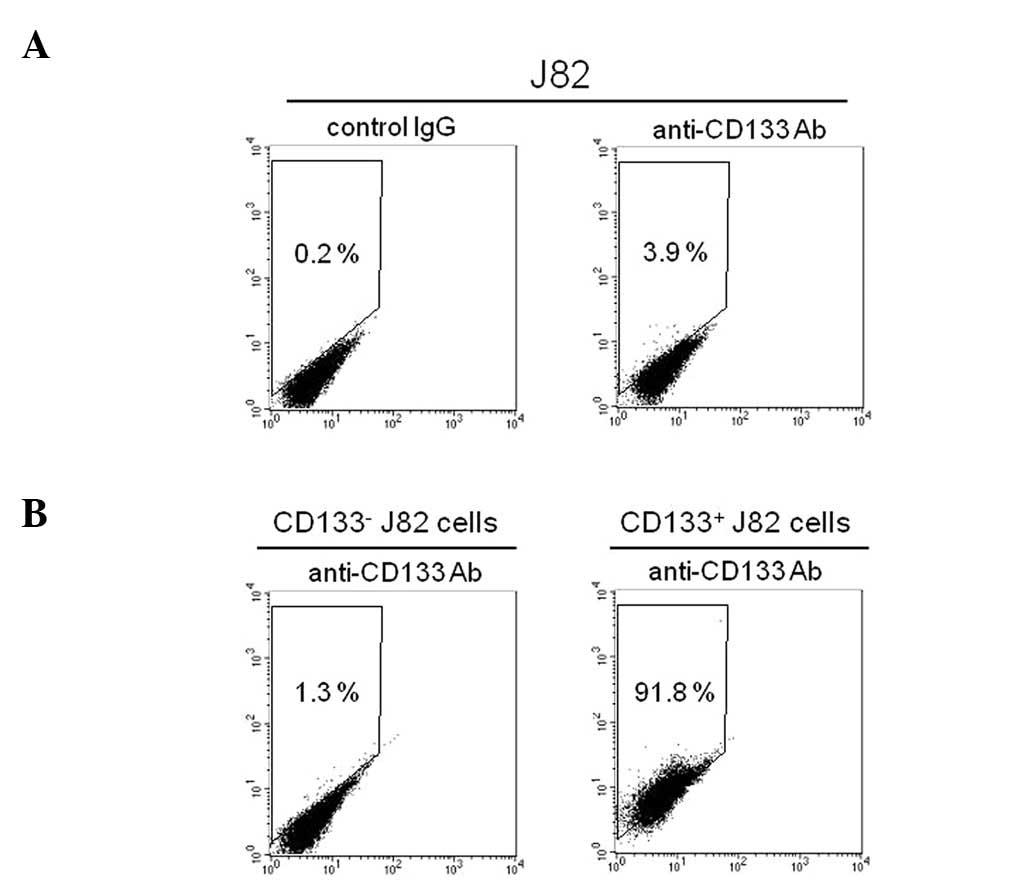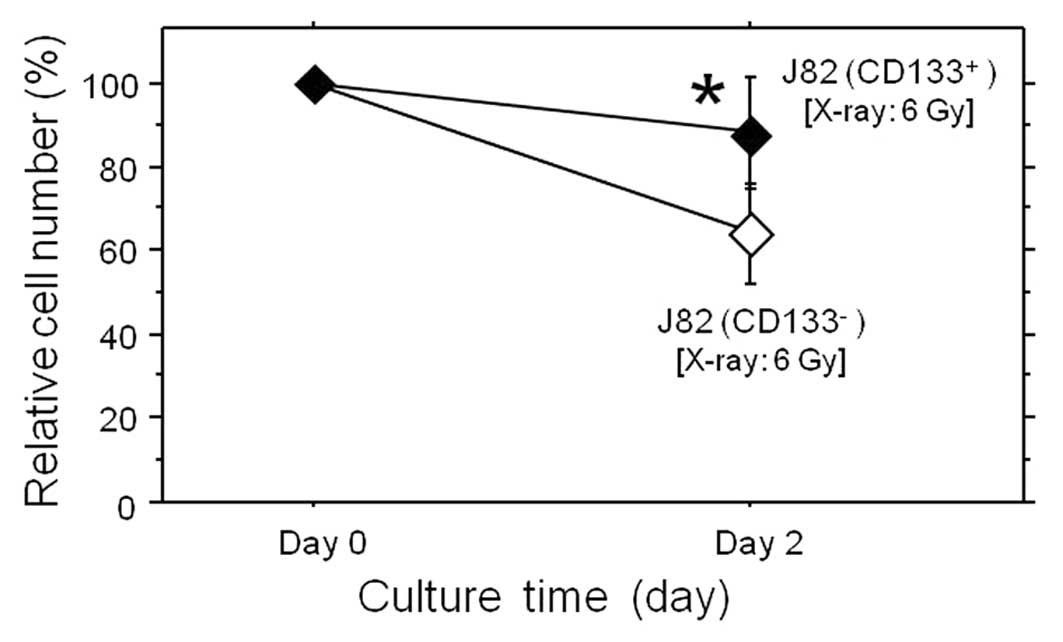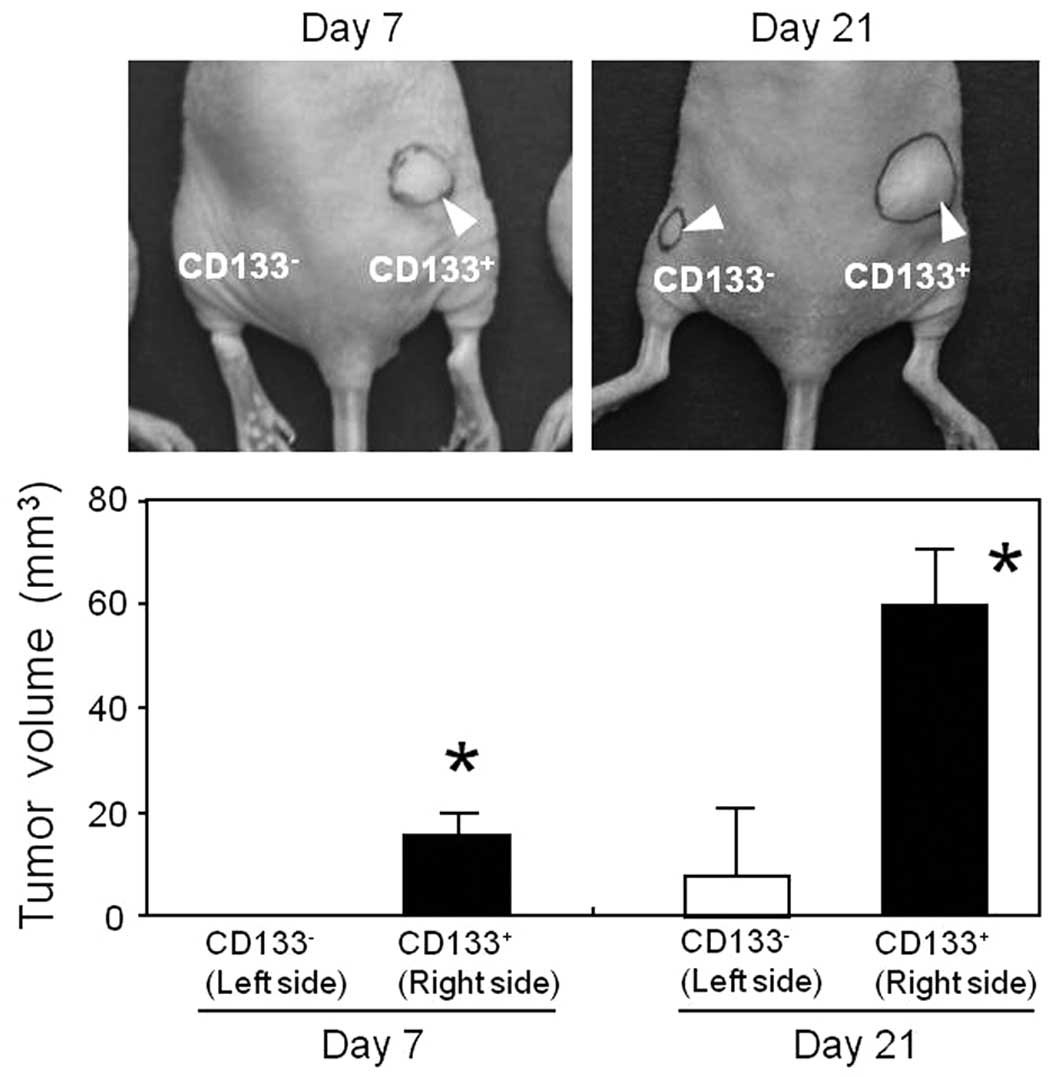Cancer stem cell-like characteristics of a CD133+ subpopulation in the J82 human bladder cancer cell line
- Authors:
- Published online on: September 26, 2012 https://doi.org/10.3892/mco.2012.29
- Pages: 180-184
Abstract
Introduction
Tumorigenesis is triggered by malignant cellular development with the destruction of healthy gene regulation systems. The cytogenetic change associated with unrecoverable genomic aberrations induces the development of abnormal cell phenotypes, such as the ability of cells to avoid undergoing apoptosis, escalated proliferative signaling, insensitivity to growth suppressors and irregularity of angiogenesis (1). Additionally, in the early phase of tumorigenesis, stemness is considered to be an important property of cancer cells. Cancer stem cells (CSCs) are, therefore, of key importance in understanding the biological mechanisms of cancer development, and are currently considered to be in the center of malignant transformation, growth and metastasis (2,3). CSCs are of increasing importance as a target for new anticancer agents. The CSCs comprise a small subset of tumor cells with a significant potential for tumorigenesis, and are identified by their expression of specific cell surface markers, which are different in the various cancer types (4–9).
CD133 is generally known to be a cooperatively expressed marker of CD34+ hematopoietic stem cells (10). The expression of CD133 is observed in hematopoietic stem cells, as well as in stem cells found in healthy tissues including the brain, kidneys, prostate and pancreas (7). According to an expression analysis of the cell surface antigens expressed in various types of cancer cells, CD133 is considered to be a promising CSCs marker for colon (2), pancreatic (5) and prostate cancers (11), as well as melanoma (4).
Bladder cancer is the second most common urological malignancy. Globally, almost 40,000 new patients are diagnosed with bladder cancer each year, with a mortality rate exceeding 150,000 per year (12). Numerous studies have been conducted to identify promising diagnostic markers and therapeutic targets for bladder cancer, in order to detect the disease earlier and to develop better treatments.
Despite the clinical importance of urinary bladder cancer, no experimental studies concerning the CD133 expression of bladder cancer cells have been conducted. In this study, the expression of CD133 and the phenotypic properties of a CD133+ subpopulation present in the human urinary bladder cancer cell line, J82, were examined.
Materials and methods
Cell culture
A human urinary bladder cancer cell line, J82, was purchased from the American Type Culture Collection (Rockville, MD, USA). The J82 cells were maintained in Dulbecco’s modified Eagle’s medium (DMEM; Invitrogen, Carlsbad, CA, USA), supplemented with 10% fetal bovine serum (FBS) at 37°C in a humidified 5% CO2 atmosphere, as previously described (13).
CD133 expression analysis in J82 cells
J82 cells were suspended at 5×105 and incubated with an anti-CD133/APC antibody (Miltenyi Biotec, Bergisch Gladbach, Germany) for 30 min at 4°C and analyzed by a FACSCalibur flow cytometer (Becton-Dickinson, San Jose, CA, USA) and the CellQuest software program (Becton-Dickinson). Incubation with the isotype control IgG (Miltenyi Biotec) was implemented to provide a negative control.
Magnetic separation of J82 cells based on their CD133 expression
J82 cells were suspended at 5×106 and separated by immunomagnetic selection, on the basis of their CD133 expression. CD133+ cells were labeled by microbeads with an anti-CD133 antibody (CD133 cell isolation kit; Miltenyi Biotec) and separated by the magnetic cell separation system, according to the manufacturer’s instructions. The separated CD133− and CD133+ subpopulations of J82 cells were expanded and stored in liquid nitrogen. The expression of CD133 in each subset was also confirmed by flow cytometry, as described above.
Observation of the cell growth pattern and cell proliferation analysis
The CD133− and CD133+ subpopulations were suspended in the complete medium and seeded in 96-well plates at 100 cells/well, in 100 μl of medium. Two days after seeding, the cell growth pattern was observed in terms of the cell capacity for colonization, and images of the cells in the plates were captured by phase-contrast microscopy. For the cell proliferation assay, each subset was seeded in 6-well plates at 1×104 cells/well, in 2 ml of complete medium. The total cell number was counted at the indicated time points.
Western blot analysis
Western blot analysis was performed as previously described (14). Briefly, the J82 cell subsets were lysed, and the extracted total proteins were separated by gel electrophoresis and transferred onto polyvinylidene difluoride (PVDF) membranes. After blocking in 10% skimmed milk, the membranes were incubated overnight with the following primary antibodies: anti-Oct-4 antibody (#2750; Cell Signaling Technology, Inc., Danvers, MA), anti-Sox-2 antibody (#3579; Cell Signaling Technology, Inc.), anti-β-actin antibody (#4970, Cell Signaling Technology, Inc.). The membranes were washed and incubated with secondary antibodies. The bound anti-bodies were visualized using an enhanced chemiluminescence detection method (ECL kit; Amersham Pharmacia Biotech, Chandler, AZ, USA).
Analysis of resistance to anticancer agents
The resistance of the CD133− and CD133+ subsets to anticancer agents was evaluated in vitro. The subsets were seeded at 1×105 cells/well on 6-well plates, in 2 ml of complete medium, and were cultured for 24 h. Either the chemotherapeutic agent, cisplatin (Sigma, St. Louis, MO, USA) (final concentration, 5 μg/ml), or the intravesical instillation agent, Bacillus Calmette-Guérin (BCG, Connaught substrain; Nihon Kayaku, Co., Ltd., Tokyo, Japan) (final concentration, 100 μg/ml), was added to the CD133− and CD133+ cell cultures. The CD133− and CD133+ cells were also cultured without any anticancer drug, while the cell number was used as a control. The relative cell number (%) was calculated for each CD133− and CD133+ subset for 4 days, subsequent to the treatment with the therapeutic agents.
Analysis of resistance to radiation
X-ray irradiation of the CD133− and CD133+ subsets was performed in order to evaluate the tolerance of the cells to radiation treatment. The cells were seeded at 1×105 cells/well in 6-well plates, in 2 μl of complete medium, and incubated for 24 h. The subsets were then subjected to a 6-Gy radiation dose. The CD133− and CD133+ cells were also cultured without irradiation, while the cell number was used as a control. The relative cell number (%) was calculated for the treated CD133− and CD133+ subpopulations 2 days subsequent to the treatment.
Analysis of in vivo tumorigenicity
Male nude mice (BALB/c nu/nu, 6- to 8-weeks-old) were purchased from the Charles River Laboratories (Tokyo, Japan). The CD133− and CD133+ cells were suspended in a 1:1 volume mixture of the medium and Matrigel (Becton-Dickinson), as described previously (15). Then, 1×106 cells of the CD133− and CD133+ subsets were subcutaneously injected into the left and right thighs of the nude mice, respectively. The tumor sizes were measured with Vernier calipers, while the volume was calculated using the following formula approximating the volume of a sphere: [1/2 x (the shortest diameter) 2 x (the longest diameter)].
Statistical analysis
Data are expressed as the means ± standard deviation (SD). An unpaired Student’s t-test was performed for the statistical analysis of the differences in the two groups. P<0.05 was considered to indicate a statistically significant difference.
Results
Identification of the CD133+ subset in J82 human bladder cancer cells
Flow cytometry was used to confirm the existence of a CD133+ subpopulation in J82 cells. The CD133+ subset comprised ∼4% of the J82 bladder cancer cells (Fig. 1A). By using immunomagnetic selection on the basis of their differential expression of CD133, the J82 cells were successfully separated into CD133− and CD133+ subpopulations. The expanded culture of the CD133− subpopulation showed that ∼99% of the cells were negative for CD133 expression (Fig. 1B). By contrast, the cytometric analysis on the culture of CD133+ cells showed that >90% of the subpopulation expressed CD133 (Fig. 1B). These results demonstrated that the J82 human bladder cancer cells consist of CD133− and CD133+ subpopulations.
Phenotypic analysis of the CD133-based subsets of J82 cells
The phenotypes of the CD133− and CD133+ subsets of J82 cells were investigated for the clonogenic capacity, the expression of pluripotent stem cell factors and their proliferation capacity. Fig. 2A shows images of the expanded cultures of the CD133− and CD133+ subpopulations. The CD133+ cells had grown, indicating their tendency to colonize, which depends on the clonogenic capacity of the cells. By contrast, CD133− cells had a diffuse growth pattern, which was identical to that of the parental J82 cells. Fig. 2B shows the results of the western blot analysis of the expression of the pluripotent stem cell markers, Oct-4 and Sox-2. The analysis demonstrated the upregulation of the pluripotent stem cell factors in the CD133+ subset in comparison with the CD133− cells. Since the transcription factor expression might alter the cell growth potential, the in vitro proliferation profiles of the subpopulations were monitored (Fig. 2C). The proliferation potential was different in the two subsets, and the CD133+ subset was significantly increased compared to that of the CD133− cells after 3 days of cultivation.
Resistance of the CD133+ cell subset to anticancer agents and irradiation
To estimate the size of the CD133− and CD133+ subsets when exposed to cisplatin and BCG, commonly used as anti-bladder cancer drugs, these agents were added to the culture medium of the subsets, and the cell growth was analyzed (Fig. 3). The tolerance to these agents was clearly different in the CD133− and CD133+ subsets. In the treatment groups, the calculated relative cell number (%) in the CD133+ subset was significantly higher compared to that of the CD133− cells 3–4 days subsequent to treatment. Thus, the CD133+ subpopulation of the J82 bladder cancer cells was demonstrated to be more resistant to the chemotherapeutic agent cisplatin and BCG in comparison to the CD133− subset. The size of these subsets was then examined against irradiation (Fig. 4). After a 2-day X-ray exposure at a total dose of 6 Gy, the calculated relative cell number (%) in the CD133+ subpopulation was significantly larger compared to that of the CD133− cells, demonstrating that the CD133+ subpopulation was markedly more resistant to radiation. These findings indicated that CD133+ cells were more resistant to anticancer treatment, while having more malignant characteristics in comparison to the CD133− subset.
In vivo tumorigenicity of the CD133-based subsets of J82 cells
The in vivo tumorigenicity of CD133− and CD133+ subsets was evaluated by inoculating these subsets into nude mice (Fig. 5). The CD133− and CD133+ cells were subcutaneously injected into the left and right thighs of the mice, respectively. Seven days subsequent to the inoculation, subcutaneous tumors were found only at the injection site of the CD133+ cells, as opposed to the injection site of the CD133− cells. Twenty-one days after the inoculation, the tumor size was significantly larger in the CD133+ subpopulation compared to that of the CD133− cells. These results indicated that there was a significant difference in the tumorigenic potential of the CD133− and CD133+ subpopulations, and that the CD133+ cells exhibited a more malignant phenotype.
Discussion
Human CD133 was first cloned as a cell surface protein expressed on CD34+ hematopoietic progenitor cells. The open reading frame of CD133 encodes 865 amino acids (AA) with a 19-AA signal peptide at its N-terminus. Its molecular weight is almost 120 kDa due to the N-glycosylation of the protein after post-translational modification (16). Although the biological functions, structure and endogenous effectors of CD133 are still being elucidated, it has been proven to be a useful marker of stemness. In addition to using its expression to identify hematopoietic stem cells, CD133 has been used to identify the tumorigenic cells in various organs, such as the colon and prostate (2,11). In the present study, the CD133+ subset of J82 human bladder cancer cells has been demonstrated to upregulate the pluripotent stem cell markers Oct-4 and Sox-2, while demonstrating a more aggressive proliferation compared to the CD133− subpopulation. The CD133+ subpopulation also had a tendency to form colonies, indicating a strong clonogenic capacity. Since CSCs were reported to have the potential for colonization in conditioned medium (2,17), while expressing the pluripotent transcription factors (18–20) in the other types of cancer, the CD133+ subset of the human bladder cancer cell line, J82 exhibited typical phenotypic features associated with CSCs.
The CD133+ subpopulation of the bladder cancer cells was also demonstrated to be more tolerant to the chemotherapeutic agent cisplatin compared to that of the CD133− subpopulation. Cisplatin exerted a genotoxic effect by means of crosslinking the cell genomic DNA and triggering cell death. The excretion of chemical compounds by ABC (ATP-binding cassette) transporters is a mechanism whereby the cells become resistant to chemotherapeutic agents (21). A previous study has found that the Oct-4 transcription factor directly binds to the promoter regions of the ABC-B1, ABC-G2 and ABC-C1 transporters, while being involved in regulating their expression (22). Since our studies demonstrated that the Oct-4 expression level was significantly upregulated in the CD133+ subset of cells, and these cells were more drug resistant than their CD133− counterparts, the resistance of the CD133+ subpopulation is likely to be linked to the upregulation of Oct-4. In this study, the CD133+ subpopulation was also demonstrated to be more tolerant to the intravesical instillation agent, BCG. Although the precise mechanism of the resistance against this anticancer agent has yet to be elucidated, the differential analysis of the molecular signaling between the CD133− and CD133+ subsets is likely to be a promising approach to identify this mechanism.
Notably, the significant radiation-resistant properties of the CD133+ subpopulation of J82 human bladder cancer cells were also demonstrated. Radiation tolerance has also been observed in the CD133+ cells derived from clinical specimens of teratoid/rhabdoid tumor (23) and medulloblastoma (24). Since findings of another study suggested that the Oct-4 and Sox-2 transcription factors provide a molecular scaffold for the activation of the DNA repair complex on the genomic DNA in stem cells (25), it is possible that these factors, which are upregulated in the CD133+ subset of J82 cells, are directly related to radioresistance as a result of an increased DNA repair after irradiation.
The in vivo tumorigenesis of the cells was also analyzed by subcutaneously transplanting CD133− and CD133+ subsets of J82 cancer cells into nude mice. The tumor growth was more aggressive in the CD133+ subpopulation compared to that of the CD133− cells, showing a significant difference in the tumorigenic potential in these subsets. The stronger in vivo tumorigenic potential of the CD133+ cells is consistent with the more aggressive in vitro proliferation of this subpopulation. Since in vivo environmental factors may affect the cell growth of the CD133− and CD133+ subsets, it would be of note to determine the ratio of these subpopulations in the tumors derived from the CD133 subsets of J82 cancer cells in a future experiment.
In conclusion, this is the first study to demonstrate the cancer stem cell-like characteristics of the CD133+ subpopulation in the human bladder cancer cell line, J82. The human bladder cancer cells were demonstrated to comprise CD133− and CD133+ subsets, while the CD133+ cells demonstrated a tendency for colonization, with an upregulated expression of the pluripotent stem cell factors Oct-4 and Sox-2, and an increased proliferation potential. The CD133+ subset was more resistant to anticancer drugs and radiation therapy in vitro, while exhibiting a more aggressive tumorigenicity in vivo compared to the CD133− subset. These results suggest that the CD133 molecule is, not only a potential marker of the malignancy of bladder cancer, but also a promising therapeutic target potentially used to develop novel anticancer drugs against refractory bladder cancer.
Acknowledgements
This study was financed by a scientific research grant (KAKENHI 23390382) from the Ministry of Education, Culture, Sports, Science and Technology of Japan. The authors would like to thank Dr Shun-Ai Li (Okayama University, Okayama, Japan) for her valuable assistance.














